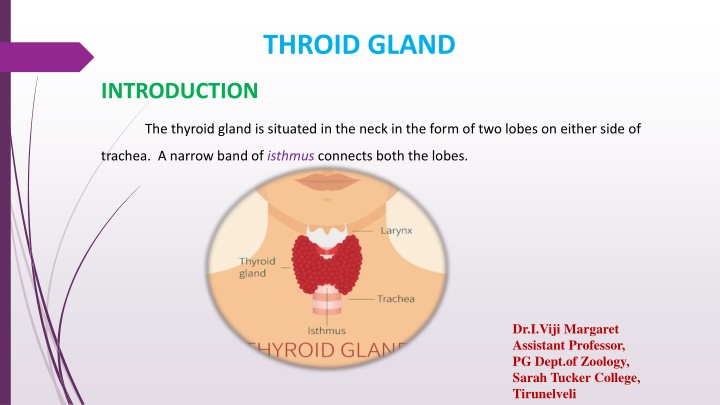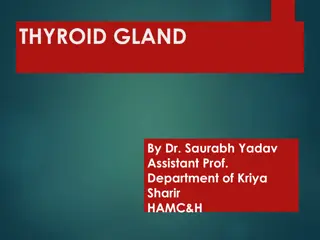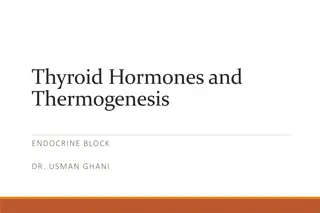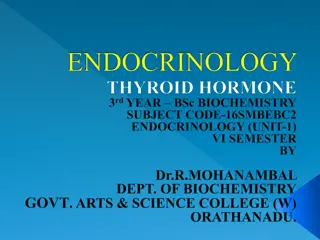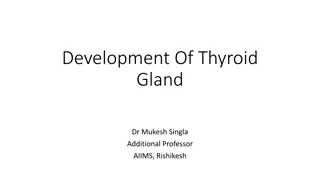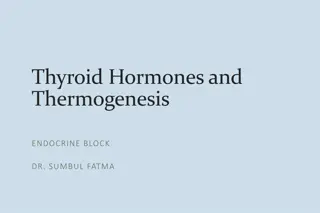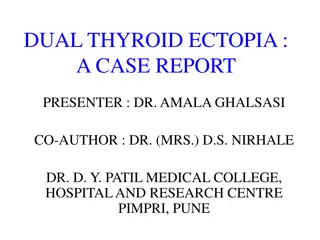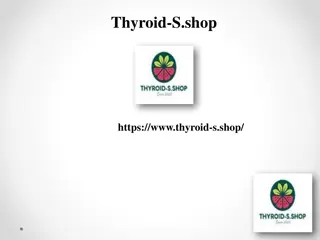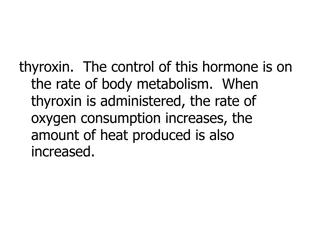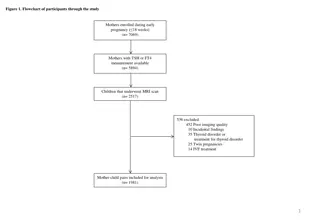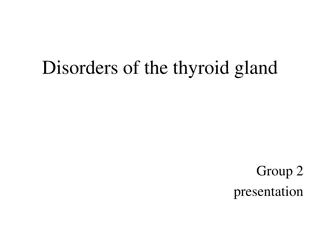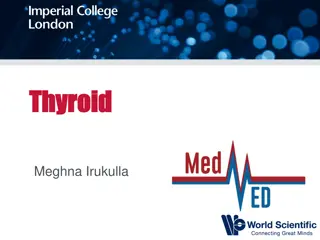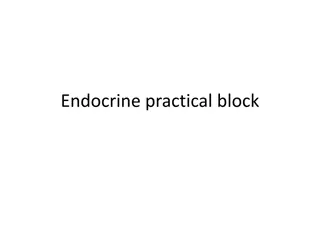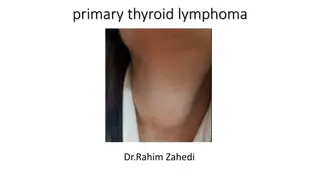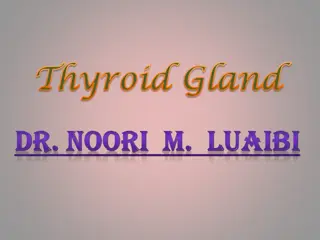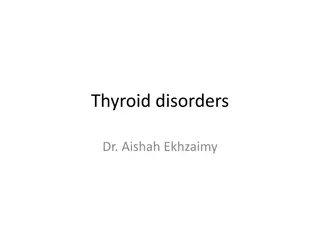The Thyroid Gland: Structure, Function, and Importance
The thyroid gland, located in the neck, consists of two lobes connected by an isthmus. It plays a vital role in energy production, metabolism, and overall physiological functions. Thyroxin and triiodothyronine are essential hormones produced by the thyroid, influencing various bodily processes. Explore the structure, function, and significance of this important gland in detail.
Download Presentation

Please find below an Image/Link to download the presentation.
The content on the website is provided AS IS for your information and personal use only. It may not be sold, licensed, or shared on other websites without obtaining consent from the author.If you encounter any issues during the download, it is possible that the publisher has removed the file from their server.
You are allowed to download the files provided on this website for personal or commercial use, subject to the condition that they are used lawfully. All files are the property of their respective owners.
The content on the website is provided AS IS for your information and personal use only. It may not be sold, licensed, or shared on other websites without obtaining consent from the author.
E N D
Presentation Transcript
THROID GLAND INTRODUCTION The thyroid gland is situated in the neck in the form of two lobes on either side of trachea. A narrow band of isthmus connects both the lobes. Dr.I.Viji Margaret Assistant Professor, PG Dept.of Zoology, Sarah Tucker College, Tirunelveli
STRUCTURE The average weight of human thyroid is about 30 to 40 gm. It is a highly vascular gland since it receives ample supply of blood (about 5 lit/hr.) through the branches of external carotid and subclavian arteries. Histologically, the human thyroid is composed of a large number of spherical glandular follicles or vesicles that are lined by cuboidal epithelium. The thyroid vesicles are filled with a colloidal material called thyroglobulin. It is an iodized glycoprotein with a molecular weight of about 680,000 and contains the hormones thyroxin and triiodothyronine. The parafollicular cells or C cells present in the interlobular space secrete the hormone called calcitonin or thyrocalcitonin.
FUNCTION Thyroxin has to play several biological functions that vary considerably from species to species. In homeotherms it is mainly concerned with energy production while for poikilotherms it serves as osmoregulatory agent and also controls metamorphosis. Thyroid hormones (both T3 and T4) influence heat production in the tissues of the body by uncoupling oxidative phosphorylation i.e., increasing oxygen utilization relative to the rate of formation of high energy phosphate bonds. Thus each mg of T3 and T4 raises basal metabolic rate by about 1000 Cal and increases the o2 consumption in most of the tissues. This effect is known as Calorigenic action. Thyroxin and triiodothyronine are essential for normal physical and mental development and in the metabolism of protein, carbohydrate and fat.
They remove calcium and phosphorus from bones leading to osteoporosis. Thyroxin increases nitrogen excretion and volume of urine through kidneys. Thyroxin hormones also have influencing role over the activity of the nervous system and voluntary muscles. The rate and depth of respiration increases under the impact of thyroid hormones since there is increase in BMR. Thyroid hormones act directly on the pacemaker of the heart thereby accelerating the heart beat rate. For the normal development and functioning of gonads thyroid hormones are essential.
Thyroxin increases the motility of the gastrointestinal tract and promotes copious flow of digestive juices. The normal texture of the skin is maintained due to thyroid hormones.
BIOSYNTHESIS OF THYROID HORMONE The tissues of thyroid gland have high affinity towards iodine. The food supplemented with iodine (from iodized salt) is digested and absorbed in the gastrointestinal tract from where iodine is transported to the thyroid gland via blood circulation. The follicular cells absorb iodine in the form of ionic iodine which is then converted into elemental iodine. Further the elemental iodine combines with the amino acid, tyrosine to form monoiodotyrosine (MIT). Further the MIT is iodinated to form diiodotyrosine (DIT). Addition of an iodine to DIT leads to formation of tetraiodothyronine (T3).
When two molecules of DIT join with each other, with the loss of the alanine side chain, there is the formation of tetraiodothyronine (T4) that is also called thyroxin. Thyroid hormones thus formed combine with the protein part namely globulin and are stored as thyroglobulin in the form of colloidal material inside the thyroid follicles. When carried in a loose complex with plasma protein. This complex dissociates at the site of target tissues and cells where they T4 secretion predominates.
